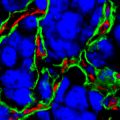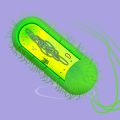
Photo: Shutterstock
Handheld breath device could 'sniff out' diabetes
A sweet-smelling chemical marker in the breath of children with type 1 diabetes could enable a handheld device to 'sniff out' the condition before a child becomes seriously ill.
That's according to news from the IOP about research reported in their Journal of Breath Research that was co-authored by Professor Gus Hancock of Oxford University's Department of Chemistry.
Professor Hancock is currently working with Oxford spin-out firm Oxford Medical Diagnostics to develop a prototype device, so I asked him about how this technology was progressing and how such a device might eventually be used…
OxSciBlog: Why is diagnosing type 1 diabetes early so important?
Gus Hancock: Untreated type 1 diabetes will result in the build-up of chemicals called ketones in the blood stream to levels which are well above normal values, and this can lead to a serious condition called diabetic ketoacidosis (DKA), when the blood becomes too acidic. This condition is the main cause of death in children with diabetes and can cause long-term problems. However, diabetes is fortunately quite straightforward to treat if caught early before ketoacidosis occurs and the child is well.
OSB: What link did you find between acetone in the breath and blood ketones?
GH: In this study we tested 113 children and young adults with type 1 diabetes for breath gases and blood constituents. The patients were all attending a regular clinic in the Oxford Children’s Hospital, and they all had their diabetes well controlled with insulin therapy.
We measured the concentration of a specific blood ketone which is used to determine the onset of DKA, and found that the values (which were all well below DKA levels) showed a strong correlation with the concentration of acetone on the breath - the higher values of the ketone were associated with higher levels of acetone. Chemically this is not a surprise it just needed to be proven in this cohort of patients.
OSB: What challenges are involved in developing a handheld device that can diagnose new diabetes from a child's breath?
GH: Let's answer two questions here. First, there are now no scientific challenges to be overcome to build a handheld device to measure acetone in breath of children or adults. The work at the Oxford Children's Hospital used a detection method called reactive ion mass spectrometry, which essentially identifies the molecules in breath by weighing them – not straightforward when there are up to 1000 detectable chemicals in breath. The instrument is the size of a washing machine and costs a quarter of a million pounds.
Our spin-out company, Oxford Medical Diagnostics, out at Begbroke Science Park, has now developed an optical technique to home in to the detection of the single most important diagnostic molecule, acetone. The technique is specific to acetone (ie it's not interfered with by the other 999 constituents) and is sensitive enough for medical needs. The prototype that we have built is the size of a shoe box, and professional designers have now reduced that to a hand held version which is shortly going into production. A single breath is processed presently in a couple of minutes, and that will decrease as we improve the engineering.
So, what would this be used for? People with type I diabetes are encouraged to test for ketones when they are not feeling well or have high blood glucose levels. This is because more insulin is needed if a child is ill, and if the insulin given is not enough, then ketones start to develop. This testing of ketone levels has to be done on a finger-prick blood test. We believe that a simple non-invasive breath test will be more acceptable (no blood required), and will be cost effective.
First, we have to prove that blood ketones and breath acetone track each other as DKA develops. We expect this: we have determined such tracking in non-diabetes volunteers when we induce mild ketoacidosis simply through diet and exercise. We envisage that the instrument will be used at home and could advise the patient whether or not ketone levels are increasing, so a decision can be made as to what should be done and whether or not hospital attendance is necessary.
Will it be used for diagnosis of new diabetes? Here we can certainly say that, if as expected, we find the tracking of blood ketones and breath acetone, it could act as a screening tool: high acetone levels will indicate that further tests are necessary. It will not immediately replace the gold standard of blood testing, but these are very early days, and we need clinical acceptance before we can make a sweeping statement about diagnosis.
OSB: What further research is needed in this area?
GH: We need more clinical data on people of all ages with type 1 diabetes, and are planning this in collaboration with the Oxford Hospitals Trust. We plan to give the handheld device to individuals so they can do frequent breath tests at home, particularly if they are feeling unwell, and we will also test patients who are admitted to hospital with DKA. For clinical use the device will need to pass a number of regulatory hurdles. And of course we are working on the handheld detection of other molecules which may be of importance in disease detection and management.
 Cancer turns blood vessels over to its cause
Cancer turns blood vessels over to its cause Vibrations reveal how material 'takes a breath'
Vibrations reveal how material 'takes a breath' Halloween special: zombies vs maths
Halloween special: zombies vs maths Brain stimulation for your stammer
Brain stimulation for your stammer The puzzle of plasmids
The puzzle of plasmids Learning to live with bears
Learning to live with bears